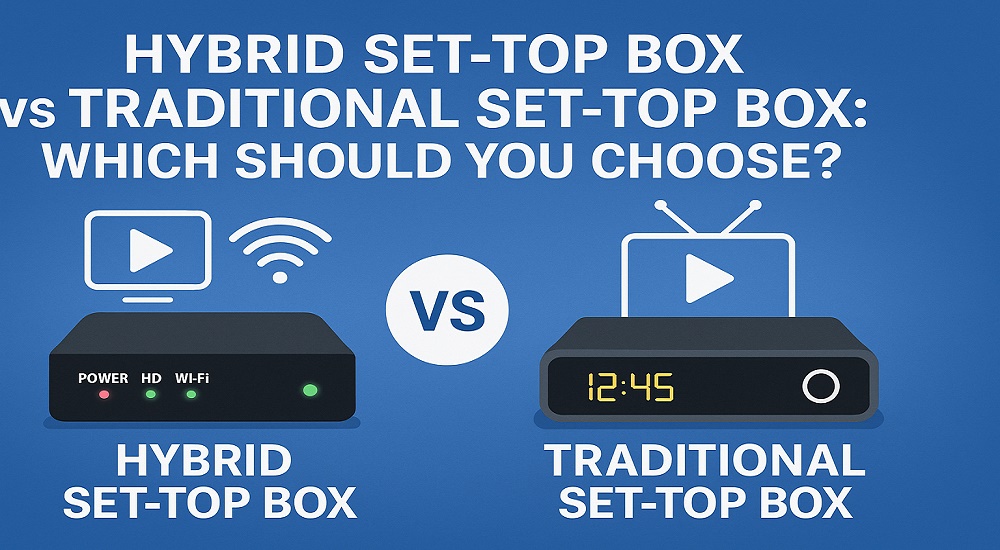Hybrid Set-Top Box vs Traditional Set-Top Box: Which Should You Choose?

In a world of entertainment options, the TV setup should be a source of happiness, not of disappointment. Still, for many people, it is a constant struggle to feel many remote controls, entrance switches, and a sense that they lack something. If your TV setup is stuck in the past, you are constantly required to choose between infinite libraries with live broadcast and streaming, you are not alone.
At the heart of this challenge lies the humble set-top box (STB). Historically, it’s been the unsung hero, translating signals into the pictures you see on your screen. But just as TV viewing has evolved from a fixed schedule to an on-demand universe, so too have these crucial devices. Most people use a familiar traditional set-top box or modern families use the increasingly popular hybrid set-top box. This guide will break down the key differences, helping you navigate the options and choose the best entertainment hub for your home.
What are Traditional Set-Top Boxes?
For decades, the traditional set-top box has been the standard for receiving television signals. Whether you’re connected to cable, satellite, or terrestrial antenna, this device is solely dedicated to one primary function: receiving and decoding broadcast signals so your TV can display them.
Key Features & Limitations:
- Pros:
- Reliable Live TV Reception: Traditional STBs are best at delivering consistent, high-quality live television, making them a go-to for sports fans, news and anyone who enjoys scheduled programming.
- Simple, Straightforward Operation: For the most part, using a traditional STB is intuitive – power on, tune in, and watch.
- Service: Many cable & satellite providers bundle a traditional STB with their subscription packages, making the initial setup seamless.
- DVR/PVR Capabilities: Most traditional STBs come with Digital Video Recorder (DVR) or Personal Video Recorder (PVR) features, allowing you to record live TV for later viewing, pause, and rewind.
Cons:
- Limited to Broadcast Content: This is the biggest drawback. Traditional STBs can’t natively access internet-based streaming services.
- Need Separate Streaming Devices: If you want to stream, you’ll need additional gadgets like a smart TV, gaming console, leading to a cluttered entertainment center.
- Reliance on Service Provider: Updates, new features, and overall functionality are dictated by your cable or satellite provider.
A traditional set-top box is best suited for individuals or households who primarily watch live television, have minimal interest in streaming services, or prefer a straightforward, no-frills TV experience. They’re also often the more budget-friendly option upfront.
What are Hybrid Set-Top Boxes?
Enter the hybrid set-top box – a device engineered to bridge the gap between traditional broadcasting and the burgeoning world of internet-based content. As the name suggests, it combines the functionalities of a traditional STB with the capabilities of a modern streaming device, offering a unified entertainment experience
Pros:
- Access to App Stores: Hybrid STBs provide access to extensive app stores.
- Advanced Features: Many hybrid STBs come packed with features like voice search, Chromecast built-in.
- 4K/HDR Content Support: Most modern hybrid STBs support 4K Ultra HD & High Dynamic Range (HDR) content for both broadcast channels and streaming services, delivering stunning visuals.
- Future-Proofed for Evolving Trends: As entertainment consumption continues to shift towards IP-based delivery, hybrid STBs are designed to adapt to new services and technologies.
- Potential for Gaming and Interactive Applications: Some higher-end hybrid STBs can even serve as casual gaming consoles or platforms for interactive services.
Cons:
- Requires a Stable Internet Connection: While live TV may function without it, a reliable, high-speed internet connection is crucial to unlock the full streaming and smart functionalities of a hybrid STB.
- More Complex for Beginners: The sheer range of features & options might seem daunting to less tech-savvy users during the initial setup.
- Potential for Performance Issues: Like any smart device, cheaper or less powerful hybrid STBs might experience occasional lag or app compatibility issues.
A hybrid set-top box is the perfect choice for cord-cutters or those considering it, heavy streamers, tech enthusiasts, and anyone seeking an all-in-one entertainment hub that provides a seamless, modern viewing experience without the need for multiple devices.
Hybrid Set-Top Box vs Traditional Set-Top Box
To make your decision even clearer, here’s a direct comparison of the key aspects:
| Feature | Traditional Set-Top Box | Hybrid Set-Top Box |
| Primary Function | Primarily for live TV broadcasting | Live TV + Internet Streaming (OTT) |
| Content Access | Broadcast channels only | Broadcast channels + Streaming apps |
| Internet Required | No (for basic function) | Yes (for full streaming features) |
| Smart Features | Limited/None | Abundant (apps, voice control, casting) |
| User Interface | Basic channel navigation | Modern, app-centric, customizable |
| Remote Control | Often limited buttons | Advanced with voice search, app shortcuts |
| Cost | Generally lower initial cost | Higher initial cost |
| Future-Proofing | Less (tied to broadcast tech) | More (adaptable to new services) |
| Complexity | Simple | Slightly more complex setup/features |
Factors to Consider When Choosing
The “best” set-top box isn’t a universal answer; it depends entirely on your specific circumstances and preferences. Ask yourself these questions:
- Individual’s Viewing Habits: Determine whether you need a wide variety of channels or specific regional/language channels, HD sports, news, or OTT apps packs.
- Internet Connection: Do you have a stable, high-speed broadband connection? A hybrid STB heavily relies on this for its streaming capabilities.
- Budget: What’s your comfortable spending range for a new device? Remember to factor in the potential long-term costs of separate streaming subscriptions.
- Smart Features and OTT Integration: If you want to access Google Play Store, voice control, Chromecast, and app installations, or want OTT integration like Netflix, Prime Video, and more.
- Existing Equipment: Do you already own a smart TV with built-in apps, or separate streaming sticks? If so, a traditional STB might suffice.
- Ease of Use: How comfortable are you with technology and navigating app-based interfaces?
Which Set-Top Box is Best to Buy?
All these brands are reputable and offer good after-sales support in India. For most users seeking a future-proof, all-in-one entertainment solution, a hybrid set-top box is the best buy in 2025.
Here is a list of the Top Hybrid Set-Top Boxes in India, with a comparison of features:
Feature / Brand | Tata Play Binge+ | JioFiber Set-Top Box | Dish SMRT Hub | Airtel Xstream Box |
| Parent Company (Indian) | Tata Play (Tata Sons & Temasek Holdings) (Indian) | Reliance Jio Infocomm (Indian) | Dish TV India (Indian) | Bharti Airtel (Indian) |
| Operating System | Android TV (Android 9.0 Pie or newer) | Android TV | Android TV (Android 9 Pie) | Android TV (Android 9.0 Pie or newer) |
| Video Resolution | Up to 4K Ultra HD | Up to 4K Ultra HD | Up to 1080i (some models may support 4K) | Up to 4K Ultra HD |
| Built-in Chromecast | Yes | Yes | Yes | Yes |
| Voice Assistant | Google Assistant | Google Assistant | Google Assistant | Google Assistant |
| RAM/Storage | 2GB RAM / 8GB Storage (typical) | Varies (often higher, e.g., 32GB storage) | 1GB RAM / 8GB Storage (typical) | 2GB RAM / 8GB Storage (typical) |
| Included OTT Apps/Bundles | Tata Play Binge app (30+ OTT apps, subscription required) | 15+ OTT apps included with certain JioFiber plans | Watcho + other popular OTT apps (some free with pack) | Airtel Xstream App + 15+ OTT apps (some free with pack) |
| DTH/Fiber Integration | Tata Play DTH | JioFiber (integrated with broadband service) | Dish TV DTH | Airtel Digital TV DTH |
| Key Differentiating Feature | Extensive OTT app integration with Binge app, popular DTH provider. | Deep integration with JioFiber broadband, including video calling, smart home features. | Budget-friendly option with essential smart features | Seamless DTH-OTT integration, strong app support |
Conclusion
Ultimately, the choice between a hybrid set-top box and traditional will depends upon your personal entertainment needs and priorities.
If your world revolves around scheduled broadcasts and limited, value simplicity above all else, and not interested in the vast universe of streaming, a traditional set-top box will serve you well.
However, if you’re looking for an integrated entertainment experience, if you’re a keen streamer who also enjoys live TV, if you desire a modern interface and advanced features, and if you want a future-proof solution that keeps pace with evolving media consumption, then a hybrid set-top box is undoubtedly the superior choice.
FAQs
What is a Hybrid Tv Box?
A hybrid TV box is an all-in-one entertainment device that merges traditional broadcast TV and internet streaming, offering viewers greater flexibility, interactive features, and a richer content experience on a single platform.
Is Set-Top Box Better Than Smart Tv?
A set-top box can be better than a smart TV if you want more flexibility, faster hardware, and broader app compatibility. Set-top boxes, especially Android TV boxes, often receive more frequent updates and support a wider range of streaming apps than many smart TVs, whose built-in systems may become outdated over time. They are also portable and easy to upgrade without replacing your entire TV.
Can a Set Top Box be Wireless?
Yes, a set-top box can be wireless. A wireless set-top box connects to your TV via HDMI or composite cables but receives its broadcast or internet signal wirelessly through Wi-Fi, eliminating the need for Ethernet cables. This allows you to place your TV and set-top box anywhere in your home without worrying about cable connections. Wireless STBs often use a Video Access Point (VAP) device to connect to your home network, providing HD or composite video output to the TV while receiving signals over Wi-Fi. Many modern hybrid set-top boxes like Tata Play Binge+ also support Wi-Fi connectivity for streaming OTT content.

